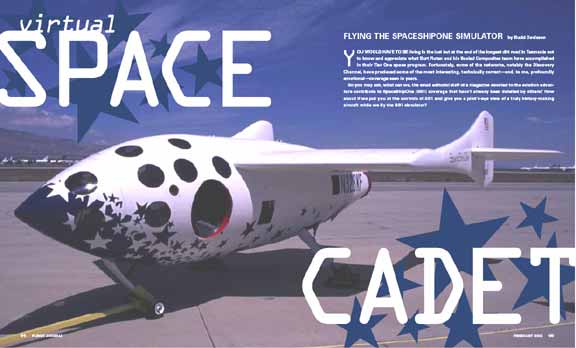I've had a lot of high points in my rather twisted career, but
none are higher than standing there on the ramp in a cold desert
morning watching Mike Melvill shove it up NASA's nose. For years
I've been crossing Burt's path when flying one of his prototypes
or chairing a design conference or any of a number of sport aviation
activities in which we were both involved. However, when I was invited
out to be part of the crowd when he announced the SpaceShipOne program,
that already had 20 flights on White Knight, there was absolutely
no doubt that all of us knew we were standing in the presence of
sheer genius. This was a man history would remember. And what made
it all so cool, is that he's one of us. Sorta. I'm going to shut
off now, or the intro will be longer than the article that follows,
but let it be known that the times I've spent around Burt, Mike
and Mike's wife , Sally, are right up there with the most important
times of my life.
You’d have to live in the last grass hut at the end of the longest
dirt road in Tasmania not to know and appreciate what Burt Rutan and his
SCALED Composites team have accomplished in their Tier One space program.
Fortunately, some of the networks, notably the Discovery Channel, have
produced some of the most interesting, profoundly emotional and technically
correct coverage seen in years.
So, you may ask, what can we, the small editorial staff of a magazine
devoted to the aviation adventure, contribute to SpaceShipOne coverage
that hasn’t already been detailed to death by others? How about
putting our reader’s at the controls of SSI as one of us gives a
pilot’s-eye view of a truly history-making aircraft while we fly
the SS1 simulator?
 |
The Man: Burt Rutan in the motor bay
of SpaceShipOne |
For those of us engrossed in sport aviation, Burt Rutan feels as if
he has just always been there. His life story has now taken its rightful
place in the annals of history, but my own involvement with him began
in the early ‘70’s when he was working for Jim Bede of BD-5
fame in Newton, Kansas. I was sitting in an office with Les Birvin (Bede’s
test pilot) and Jim Bede, when a tall, excited guy burst through the
door.
|
“I’ve got it, I’ve got it,” he said, as he threw
some papers and napkins on the desk. His energy was so high, that if
the lights had been off, he was probably giving off blue sparks. He
had just returned from a trip, but prior to his departure an idyll conversation
had taken place about what it would take to keep an airplane in the
air indefinitely. On that trip Burt’s brain wouldn’t leave
the subject alone and he came back with tons of thoughts and calculations.As
I remember, it involved using CDS cells to drive electric motors.
Today, thirty years later, Burt Rutan is still giving off sparks and
his achievements have kept stacking up until it’s obvious that
history will eventually count him among the most important influences
in aviation. He and I have zigzagged back and forth across each other’s
paths constantly during his odyssey. Ditto for Mike Melvill and his
oh-so-patient and brave wife, Sally. For that reason, like so many others
they have touched, the Tier One program meant a lot to me personally.
I dropped Burt a note asking if I could come out and fly the simulator
in an effort to understand what kind of craft Mike and the other SCALED
pilots had to cope with. Just describing what they’ve done is
one thing, but to truly understand it, I felt I needed to sit at the
controls and experience it. Well, not really experience it, since I’d
be sitting in a hangar in the Mojave Desert, not perched on a cone of
flaming rubber 62 miles straight up. Burt immediately answered my e-mail
with “Sure come on out.” And so began my quest to become
a virtual astronaut.
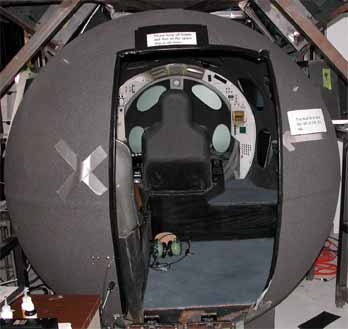 |
The door to the best video game on the
planet! |
First it should be understood that you don’t buy a simulator
for a revolutionary form of spacecraft off the shelf. Like everything
else the SCALED team did, along with designing and building their own
launch aircraft (White Knight), they designed and built their own simulator
right down to writing all of the required computer code.
I spent quite a bit of time getting a cockpit checkout sitting in the
launch ship, White Knight, from Steve Losey, the crew chief, so when
I crawled into the SS-1 simulator I was at least familiar with the general
layout, since the two cockpits are practically identical.
The simulator itself is a composite (what else?) eggshell suspended
in a web of steel supports. Next to the door is a white line labeled
“If you aren’t at least this tall, you can’t ride
this ride.” Above the door, a similar sign says, “Keep arms
and legs inside the spaceship at all times.” Humor has always
been key to the entire Rutan operation.
The seemingly odd arrangement of the windows, which is dictated as much
by structural demands as ergonomics, gives sight angles probably 10-15
degrees either side of straight ahead, but straight ahead you’re
looking at the back of the nose hatch. In fact, the control panel (the
TONU), rudder pedals and about everything from the pilot’s knees
on down is jettisoned along with the nose hatch giving free access straight
ahead. But, when flying you can’t see squat right in front of
you.
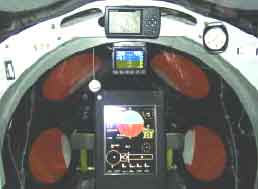 |
The camera is about where your eyes would
be. The TONU system sticks up between your legs and the rudder
pedals are on either side of it with the nose windows behind those.
A Dynon nav system is on the top cabin bow as a back-up. |
When you wrestle your way into the centrally mounted pilot’s
seat you’re struck by the seeming simplicity of everything. You’d
expect a massive array of system controls and computers but other than
a couple of rudimentary control panels, including the environmental
control system panel and some switches including those for launch arming
on the fuselage frame above you, basically all you have is the stick,
rudders and a rectangular box (the TONU) that sticks up between your
legs.
The TONU (Tier One Navigation Unit) IS the airplane. Every bit of avionics,
instrumentation and system monitoring is in that black box. It’s
a CRT probably a foot wide by 18 inches tall that is split into two
pages, top and bottom. The presentation on the top half is the flight
direction system and the bottom half is a multi-page presentation that
can be scrolled through to view a wild array of information about what
the craft is doing and how the systems are functioning.
The page that is usually displayed on the bottom during flight is a
horizontal situation map that continually shows the pilot where he is
in relation to Mojave Air (now Space) Port and what he needs to do to
make it back to the airport. Remember, this is a glider and going around
after a bad approach isn’t an option. Maybe that’s what
the One in SpaceShipOne means: you get one shot at landing it, so you’d
better be on the ball.
 |
The heart of SpaceShipOne: the TONU all-knowing
system. The flight data is on the top half and the bottom half
can be scrolled through about a dozen screens that tell you different
parameters about the various systems. |
The top half, the flight systems presentation, is dominated by a big
artificial horizon, a variation of the same type of instrument seen
on the panel of practically every airplane built in the last sixty years.
It has to be remembered that SS-1 is hand-flown. In this day of computerized
everything, Rutan’s guys went into space the same way Lindbergh
crossed the Atlantic, by hand. Even though the highly computerized TONU
is giving the pilot all the information he needs to fly the right profile,
it is the pilot who actually controls the craft.
The artificial horizon differs in one major way from the normal general
aviation version: it is capable of full 360 degree movement in all directions,
which allows the pilot to command straight up and straight down attitudes.
The other critical flight information is displayed on the same screen
as the artificial horizon, e.g. in the upper left corner you have indicated
airspeed (actually, equivalent indicated airspeed, which is IAS corrected
for compressibility effects) while the altitude and rate of climb is
prominently displayed in the upper right.
A cross in the lower right displays the yaw and pitch trim position
as well as stick and rudder position. In a quick glance you can instantly
tell where the airplane is going and how well it’s doing as well
as monitor what position the controls are in.
My first flight was a gliding drop from 50,000 feet and it was a real
eye opener. Stick almost full back (the gray mark on the bottom of the
cross), a short count down and the airplane falls free. Whoa! Instantly
it dropped the left wing 20-30 degrees, then, as I was thinking about
correcting, it rocked into a bank the other way. Then left again. It
was classic Dutch roll where an airplane, with no input from the pilot,
rolls uncontrollably from one bank angle to another. It’s not
only disconcerting, but the natural instinct is to stop it, but it didn’t
take long before I realized almost everything I did made it worse. Sometimes
much worse. At one point I was in a ninety degree bank. Not cool!
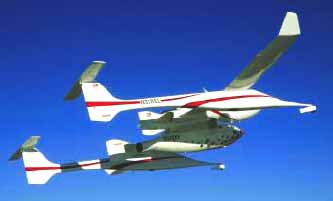 |
White Knight with SS1 and Mike Melvill
on the way to make history. |
While fighting the rolls with the ailerons (actually elevons) and trying
to coordinate with the rudder I discovered another characteristic of
the airplane: it has a HUGE roll/yaw couple. Get the nose just a little
to one side and the wing drops almost violently in that direction. This
was further compounded by the rudder pedal pressure: to eliminate the
possibility of a pilot accidentally inducing yaw by resting a foot on
the pedal, the rudders are spring loaded to neutral. And I mean REALLY
spring loaded. It took all the strength I had in one leg to push the
rudder all the way down.
So, I’m chasing level flight while trying to maintain a reasonable
speed. We’re dropping like a stone and it suddenly dawns on me
that I have to try to find the airport. The navigation map has an airplane
icon (me and SS1) and a buggy whip type of line attached to that icon.
It curls around, continually changing as it shows the pilot which direction
he has to turn from any given position to arrive abeam the airport on
downwind at 8,500 feet.
With a little coaching from Jim Tighe, SCALED’s chief aerodynamicist,
I managed to get within sight of the airport. By that time we were down
to around 30,000 feet and the airplane was beginning to act more and
more like a regular airplane. By 20,000 feet, there was nothing at all
unusual about the airplane and holding 130 knots KEAS (Knots Equivalent
Air Speed) for the approach was no big deal. What was a big deal was
trying to keep track of the airport through the tiny windows. There
it is, oops lost it, I’ll catch it in the next window.
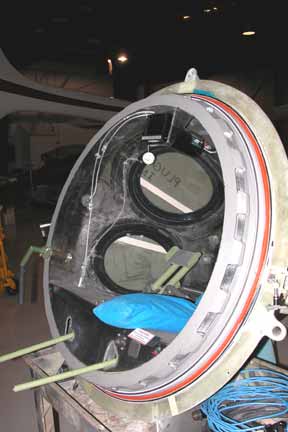 |
The nose section and its locking ring.
This is the portion they unlock and blow off, should the pilot
decide to bail out. The TONU and rudder pedals go out with it. |
Each window on the simulator has it’s own CRT and it’s
amazing how real the entire visual system feels. I totally forgot this
was a simulator. These guys ought to forget about space and start building
arcade games. They’d clean up.
Several weeks earlier, I had been at Mojave and watched Mike land after
qualifying as an astronaut so I knew I’d be making a curving approach,
which is the way I land my own airplane anyway. I also knew it would
be a high approach, but when I was at 4,000 feet on short final and
Jim Tighe says to hold off putting the gear down to make sure we have
the runway made, it drove home the point that this thing glides like
an anvil. Plus, the gear doors are ready-made speed brakes.
On that first approach I totally forgot about the blind spot ahead because
I was curving toward centerline, while watching out of the foremost
windows and I fell good about the profile. Then I intercepted centerline
and lost the runway entirely. It didn’t dawn on me until the second
flight to lean sideways out of the seat to maintain some contact with
the edge of the runway. I leveled too high, so didn’t see the
edges of the runway again until too late. I wound up skidding through
the dirt 25 feet to the left of the runway. Fortunately both the simulator
and me survived without a scratch. Now it was time to go for space.
The most important controls for the pilot reside on a simple looking,
flat console under his left arm. At the very front is a huge knob for
the yaw trim and in watching flight movies later, I noticed Mike flew
a lot of the flight with a hand on that knob. Especially during launch.
Three, two one, I’m dropped. The guards on both switches were
already up. I hit the left arming switch, then hit the right one. In
the sim I didn’t have the 2 G kick in the butt the real pilots
felt but instantly the airspeed started climbing. As it did, an icon
was projected on a vertical line through the TONU: that was the target.
Keep the nose on that icon and the airplane would get maximum altitude
out of the rocket motor burn.
The airplane is rocking left and right and I’m struggling, really
struggling, to maintain a level attitude while putting the nose on the
icon. The pitch trim switches on the top of the control stick became
very handy at that point. As I fought to hold attitude, I glanced at
the altitude read-out and had to grin—it showed me blasting through
200,000 feet with a climb rate of 150,000 fpm. That’s 1700 mph
straight up!
In what seemed like seconds the rolling tendency died away as the atmosphere
fell behind and the controls got increasingly lazy with no air to push
against. It was fascinating to watch the interplay between “true”
and “indicated” airspeed on the TONU. Indicated airspeed
is actually a measure of how densely packed air molecules are. Even
in light planes at altitudes as low as 8,000 feet the indicated airspeed
lags the true airspeed by as much as 10-20 mph because the air has thinned
out. The molecules are further apart so they aren’t hitting the
pitot tube as often as at lower altitudes. All of the aerodynamic and
structural effects of flight are grossly affected by this phenomenon.
To put loads (G’s) on an airplane, the airplane needs air to push
against, so the thinner the air, the lower the structural loads become.
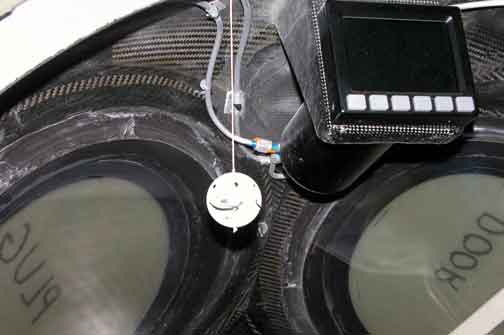 |
The famous anti-gravity ping-pong ball.
when the string wrinkles, you know you are a long way from home.
|
As the atmosphere fell behind, I watched true Mach numbers hovering
around 1.0-1.5 while the airspeed was winding down through 40 knots,
to 30 knots, then zero, With no air to generate forces on it’s
control surfaces, as far as SS1 was concerned, it wasn’t seeing
any more activity than it would sitting on the ramp regardless of how
it was tumbling around.
Since the normal control surfaces weren’t working, SS1 started
a lazy sort of roll, which was actually some motion left over from earlier
because it was just floating. When Mike experienced the high rotation
rolls going up hill on the first X-prize flight, he later commented
that if it had started spinning later, after he had left the atmosphere,
he would have had more problems. That was because in the atmosphere
the aerodynamic controls would eventually arrest the roll, but out of
the atmosphere he’d have to rely on the relatively low power of
the RCS, the reaction control system.
Out of the atmosphere the controls consist of compressed air thruster
nozzles molded into the top and sides of the nose and the top and bottom
of each wing tip. When the control stick was pushed to the limit, it
hit a microswitch that triggered the thruster on that side.
In a zero G environment, you’re not so much concerned with the
rate at which a control change takes place as much as you are the acceleration.
Once you start it moving, it’ll continue accelerating so all you
really want to do is nudge it one way or the other. This requires nothing
more than a gentle tap with the stick to get the effect you want. It
was an interesting and thoroughly controllable control experience and
almost relaxing after the intense, constantly-working-your-butt-off
ride up.
As we approached apogee, as indicated by the rate of climb, Jim Siebold,
one of the SCALED test pilots who had taken over coaching me, called
for feather deployment. I pulled a large lever under my left arm up
to unlock the feather, waited until the TONU told me it was unlocked,
then pulled the feather lever.
The feathering concept works in combination with Rutan’s thoughts
about weight. For its size, the SS1 is extremely light and comparing
it to something like the Space Shuttle or X-15 is like comparing a ping-pong
ball with a rifle bullet. The other airplanes are slick and extremely
heavy for their size. They are dense, which results in what’s
known as a high ballistic coefficient: gravity can speed them up easily
and, because of their clean shape, they’ll hang on to their speed
even as the atmosphere gets thicker. This is where aerodynamic heating
becomes a problem and this was something Rutan avoided in the SS1
He not only wanted to keep the ballistic coefficient down but he wanted
the ping pong ball to have extremely high drag so the second it senses
any atmosphere at all, it would start slowing down. In feather mode
the airplane literally breaks in half as the tail cants up, which presents
an extremely high drag profile to the increasing atmosphere. By keeping
it slow from the beginning, reentry problems are greatly eased.
Another benefit of the feather mode is that the airplane more or less
self-aligns like a badminton birdie and automatically assumes the right
attitude to hit the atmosphere. The X-15, like the Shuttle, was extremely
critical to having both the flight path and the relative angle of the
airplane accurate within two or three degrees or it was in trouble.
In fact, one did break up on re-entry when the angles were wrong.
In the SS1, once in feather, the airplane is so stable and self-aligning
that the pilot doesn’t have a thing to do but wait until it’s
down to around 60,000 feet, when he puts it back in glider mode and
he starts worrying about finding the airport.
The foregoing is a brilliant concept. It removes the single most terrifying
and critical part of space flight. The SS1 never sees indicated re-entry
speeds higher than about 130 knots even though mach numbers are approaching
3.2 so it never gets hot. Its thermal protection is a coat of proprietary
resin of some kind that’s a tenth of an inch thick. Contrast that
to the Shuttle’s cumbersome tile system.
In the simulator I had none of the rumbling noise during reentry that
Mike reported as being “scary,” so it was a no-sweat ride
down. At 60,000 feet I went back into feather mode and flew it back
down. The Dutch roll gets less and less and, once I figured out the
navigation display and could find the airport, life was good. I topped
350,000 feet twice and both times got the airplane back on the runway.
So, I guess that makes me a virtual astronaut.
My everlasting impression of the entire Tier One program and the SS1
is how brilliantly simple everything is. The SS1 control system, for
instance, is nothing more than push rods just like a normal airplane.
The horizontal tail surfaces give both pitch and roll and the horizontal
stabilizer is electrically trimmable and the airplane can be flown with
one side completely inoperative since the spacecraft has redundancy
in all of its systems.
On a personal note, even though Burt is a terrifically friendly, humorous,
easily approached individual I have to be honest and admit that he intimidates
the hell out of me. Even though I’m an aeronautical engineer (primarily
structures) by training and an experienced pilot, without meaning to,
his very presence is a continual reminder of where the rest of us fit
in the intellectual food chain. He’s up there in the rarified
atmosphere peopled by only a few true geniuses, while the rest of us
are down here slogging along in the muck of mental mediocrity.
The really scary part about Burt Rutan is that I think we’ve only
seen the tip of a gigantic iceberg and he’s just now hitting his
stride. The next ten years are really going to be exciting. As he is
fond of saying, “Things are looking up…way up.”
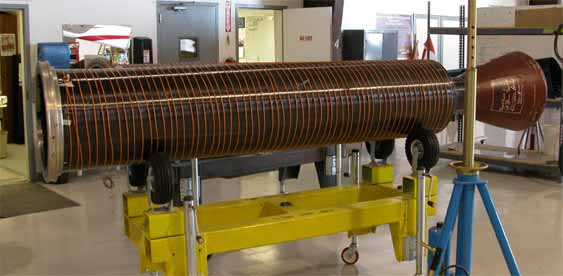 |
The core of the rocketmotor is a perforated
log of hard rubber, which is nearly pure carbon. When this is
ignited in the presence of liquid oxygen, you get a white hot
, high speed burn. the light lines are electrical circuit wire
wrapped around the rocket. If there is a breech, it will burn
a wire and shut down the oxygen pumps and the fire goes out. |
Going to space on burned tires
By now everyone knows that the SS1’s rocket motor burns rubber,
but we thought we’d expand on that a little.
Technically the motor, which was designed and patented by Rutan and SCALED,
is what’s known as a “hybrid” motor because it’s
neither pure solid nor pure liquid fueled. The solid fuel core is a log
made of Hydroxy-Terminated Polybutabiene (HTTB), which is nothing more
than synthetic rubber. The fuel log is 20” in diameter with approximately
4” walls with 4” partitions cutting through the center creating
four pie-shaped cavities full length.
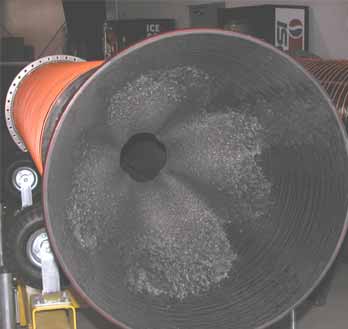 |
And the music comes out here. |
The front of the carbon fiber motor is bolted to a flange that is bonded
into the back of the composite liquid fuel tank. The liquid part of the
fuel combination is Nitrous Oxide, which dentists use to put their patients
to sleep (laughing gas) and turns the lowly Honda street car in to a roaring
tiger (Nitrous Oxide injection). The bulkhead between the tank and the
rocket has a valve in it surrounded by a ring of small rocket motors that
act as ignitors.
Both NO2 and HTTB are totally stable in their natural state and won’t
react with one another, which is one of the real safety features of the
hybrid concept. However, use the ignitor motors to get the rubber burning,
then pump in NO2 under pressure as a super-oxidizer and you have a serious
flame going. The expanding gas is accelerated through the nozzle and instantly
you have thrust.
The motor is wrapped in electrical wire, which is a safety system: if
a hole appears in the rocket case, it burns a wire in half, which shuts
the valve and just that fast, the rocket shuts off. Like everything else
in SS1, the propulsion is brilliant in its simplicity.
